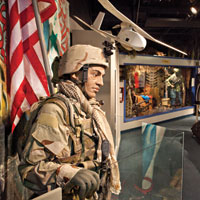 SEAL Museum gets boost from
SEAL Museum gets boost from
bin Laden raid
The bullet holes form a circle just above the lifeboat’s entryway -- exit holes, now filled with epoxy. The bullets ripped through the boat’s fiberglass shell on Easter Sunday 2009 as Navy SEALs, firing at the bobbing boat in the Indian Sea, shot and killed three Somali pirates.
The bow of the dusty-orange life boat points toward the passing traffic on A1A, vying for the attention of passersby with other boats, aircraft and various personnel carriers. The boat is the most recent artifact at the National Navy UDT-SEAL Museum that people might remember.
Now, Museum Director Richard Howard is hoping the museum at the southern end of our barrier island will soon have for a new, even hotter main attraction -- artifacts from the SEALS’ latest exploits, the raid on Osama bin Laden’s safe house in Pakistan.
The bin Laden raid ignited interest in the SEALS and the museum.
Howard says the number of visitors to the museum spiked dramatically after the May 1 raid. He says staff has been swamped with phone calls and requests for interviews, including Curator Ruth McSween’s appearance May 7 on Geraldo Rivera’s FOX News show.
The dramatic ping in attention and the pursuit of bin Laden material comes at a significant time for the museum, which plans to complete an 8,500-square-foot addition that will triple the size of its now cramped facility.
Howard says the addition cost about $800,000 and should be done by July. Construction was paid for with St. Lucie County bed tax money and a donation from a museum board member.
The addition will probably take another two years and $1.5 million more to finish before it’s complete. That will pay for construction of displays and moving SEAL artifacts out of storage and into the new building.
“It will take some time to build the permanent exhibits, “ says Howard, a SEAL from 1977-2003.
“The SEALS have a lot of very interesting stories to tell and we want to do that in a first-class manner and that takes money,” says David Godshall, the assistant chairman of the museum board, who led the fund raising to build the SEAL memorial that was unveiled in November and carries the names of the 253 names of SEALS killed in combat.
The museum, Howard says, is not a static point in time which is why he went after the Maersk Alabama lifeboat and now hotly pursues SEAL artifacts from the bin Laden raid. “We have some connections,” he says with a slight smile.
Howard says the museum wants weapons from the bin Laden raid, documents, models, clothing and photos. “We will be looking for what’s not classified or what has been declassified, he says.
Howard, of Vero Beach, hints he might have inside help in pursuing the bin Laden materials. “Our small SEAL community knows we exist,” he says, adding only about 2,500 SEALS are in service at one time.
The tight-knit group remembers its own with great reverence. That surfaces quickly as Howard points to the recently dedicated memorial wall with the SEALS names. The most recent name etches into the stone just a few weeks ago.
“Ryan C. Job,” says Howard. “He was shot in the eye. He didn’t die under fire, but a few years later when he was undergoing follow up surgery.”
Godshall and Howard walk a visitor through the currently cramped museum, built on the site where SEAL predecessors , Underwater Demolition Teams (UDTs), trained on the barrier island beaches from 1943 to 1945. Thirty-five-hundred of them, 20, 100-man teams, trained on the island.
The exhibits show the black and white photographs of tents lining the beaches and an array of underwater breathing apparatuses that include one of only two re-breathing devices used by frogmen in WWII.
Another display illustrates SEAL weapons and how the weapons are adapted for missions with scopes or lasers or belt-fed ammunition.
The displays fill the current museum’s tight quarters, but that should be alleviated in the coming months. The addition will house a larger theater, provide more space for the gift shop, more displays and includes a food preparation area and conference rooms for presentations.
Howard stops by a display of five SEALS who won the Medal of Honor, including Bob Kerrey, former Nebraska governor, senator and presidential candidate.
“You are often asked what a typical SEAL looks likes. “Some are unassuming,” he says. “Some are gung-ho.”
SEALs undergo 27 weeks of initial training and 22 weeks of SEAL qualifying training before they are assigned to a team. “You might train another year before you’re put in a war zone,” Howard says.
Godshall, a barrier island resident who was a SEAL from 1981 to 1989, says the training is tough and constant. “Training is dangerous,” he says. “They use real ammo. You undertake real night parachute jumps. You can’t do that sitting around and watching it on TV.”
“Bin Laden was just another night operation,“ Howard says matter-of-factly.
But it wasn’t and SEAL pride in the operation permeates the museum as does its respect for those still serving.
“This is the only place the public can get a glimpse of the SEAL part of the Navy,” Howard says. “These guys and their families make tremendous sacrifices. That’s worthy of a first-class museum. “








